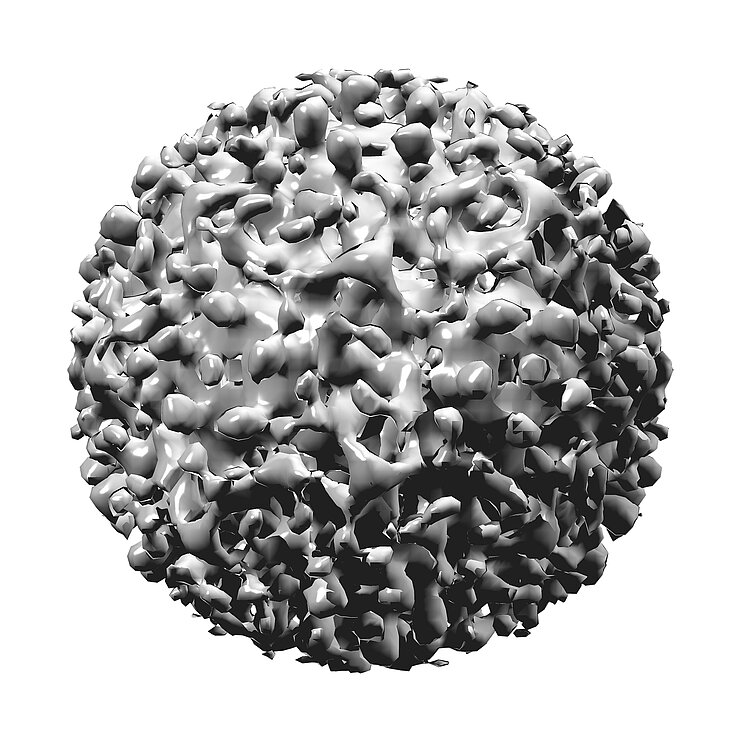Viral hepatitis
Liver inflammation is usually caused by an infection with hepatitis viruses. But it can also be caused or exacerbated by alcohol abuse, a certain fungal toxin or medication overdosing.
The five main types of hepatitis viruses are hepatitis A, B, C, D, and E, of which various genotypes and subtypes are meanwhile known. The classical hepatitis viruses A - E differ from each other in many ways, for example in their transmission, the clinical symptoms and the severity of the health effect. Especially the hepatitis viruses that lead to chronic diseases often manifest without symptoms early in the infection. According to a global survey, approximately 1.45 million people succumbed to the consequences of a viral hepatitis in 2013 and 96 percent of these fatalities were caused by hepatitis B and C viruses. Since hepatitis infections are not always associated with conspicuous symptoms right away, the World Health Organization WHO and the World Hepatitis Alliance presume that some 90 percent of the more than 300 million infected individuals have not been diagnosed with their disease.
If the body's defence system fails to prevail against the viruses, the hepatitis turns chronic. In the absence of treatment, the patient faces the prospect of severe liver damage up to liver cirrhosis or even liver cancer in the long-term. Chronic infections are mostly associated with hepatitis B or C viruses and account for approximately 72 percent of all fatalities caused by liver cancer.
Hepatitis B
Hepatitis B is one of the most common infectious diseases on a global level and is transmitted by body fluids of infected individuals. According to epidemiologic estimates, at least 250 million people throughout the world are chronically infected with HBV. Although medical treatment of chronic hepatitis B is possible, the disease cannot be cured at this time. In order to prevent HBV infection, the German Standing Committee on Vaccination (STIKO) recommends since 1995 that all infants and young children should be vaccinated against hepatitis B, as they bear the highest risk of chronic infection. In adults, the STIKO in Germany recommends the hepatitis B vaccination for people with an increased infection risk, for example individuals living with HIV/AIDS, dialysis patients or persons in contact with hepatitis B infected individuals.
In one study, researchers from the HZI's Department of Epidemiology investigated how the prevalence of chronic hepatitis B infections has changed in 50 countries over the past decades. Although they noted a worldwide decrease, there are areas, in which the prevalence is unchanged and high or even increasing. Currently, the epidemiologists are conducting a study in Burkina Faso in West Africa, in the course of which more than 4000 individuals were serologically tested and interviewed. The study aims to attain precise information on the epidemiology of chronic HBV infections, the immune status, and the risk factors in the population of this country. The results can assist health policy in order to specify prevention needs and treatment options.
Hepatitis C
An estimated 70 million people live with a chronic hepatitis C infection. The transmission of this virus is mainly via the blood. Some 400,000 people succumb to the consequences of hepatitis C each year. By now, there are some new effective antiviral medications available (direct-acting antivirals, DAA) that can eradicate the infection in 95 percent of all patients. However, these therapies are very expensive and are not effective against all genotypes of HCV such that only a small number of patients gets to benefit at this time. Moreover, healing by medication does not protect from re-infection with the hepatitis C virus in the long term. Researchers are therefore working intensively on the development of a vaccine. This requires a model system that can be used to test new vaccines and drugs. To this end, HZI researchers from the "Vaccinology and Applied Microbiology" department of Prof Carlos Guzmán are developing a mouse model of hepatitis C, since mice are not actually susceptible to this virus.
Adapting mice to the hepatitis C virus is also a focus of the research group of Prof Thomas Pietschmann, a virologist at the TWINCORE, which is a joint facility of the HZI and the Hannover Medical School. Aside from other projects, Pietschmann's team investigates the durability of the virus on different surfaces and searches for new drugs against hepatitis C. They already discovered a promising candidate: a plant-derived substance called Ladanein.
Hepatitis A, D und E
The transmission pathways and clinical pictures of infections by hepatitis A viruses (HAV) are different from those of HBV and HCV. Accordingly, the hepatitis A virus is usually transmitted in the presence of poor hygienic conditions by contaminated water or food items or contact with an infected person. In almost all cases, the immune system eliminates the viruses. In the aftermath of an HAV infection or vaccination against the virus, the respective individual is usually protected from re-infection for a long time, presumably life-long. Especially in European countries, in which the prevalence of HAV is low, the majority of the adult population is not serologically protected from infection. This is mainly due to the fact that only few people had an HAV vaccination at child age or experienced an HAV infection.
The Department of Epidemiology supports investigations of prevalence and the immunity to HAV of the population in Europe. The researchers also developed a method that allows differentiation between immunity acquired by vaccination versus and immunity acquired through infection. The developed serological test is foreseen to be applied for the first time in a study in Columbia. Specific HAV vaccination strategies, for example in terms of the age group and dose, are implemented in Latin and South American countries. In these countries, the test allows to address relevant questions on the duration of the protection after vaccination or the susceptibility to HAV infection.
Hepatitis D virus needs the aid of hepatitis B virus for its proliferation and occurs only in combination with HBV. Thus far there are hardly any treatment options allowing HDV to be cured in the long-term and the most effective protection is vaccination against hepatitis B.
The transmission of hepatitis E virus (HEV) varies depending on the geographically prevalent genotype. In countries like India, the virus is usually transmitted by faeces in water or food items, whereas the predominating genotype in Europe is transmitted mainly from animals to humans and upon consumption of insufficiently cooked pork or game meat products. Some 20 million people are estimated to harbour the virus and 44,000 succumbed to it in 2015. In certain groups of individuals, such as pregnant women and immuno-compromised persons, the infection can take a severe course or turn chronic. A vaccine against the infection has been developed, but has been approved only in China thus far. The HZI's department "Epidemiology" systematically assesses scientific epidemiological data on the prevalence of hepatitis E virus in Europe and identifies various influencing factors.
Strategy against hepatitis
The WHO set the ambitious goal to "eliminate" viral hepatitis as a global threat by the year 2030. For this purpose, the WHO established a catalogue of measures that would reduce the number of new infections by 90 percent and the number of fatalities by 65 percent. The strategic measures are meant to guide countries and global partners through the necessary political, social and scientific developments.
( jot, afi, jgr )
Involved research groups
-
Epidemiology
 Dr Berit Lange
Dr Berit Lange -
Experimental Virology
 Prof Dr Thomas Pietschmann
Prof Dr Thomas Pietschmann -
Vaccinology and Applied Microbiology
 Prof Dr Carlos A. Guzmán
Prof Dr Carlos A. Guzmán











